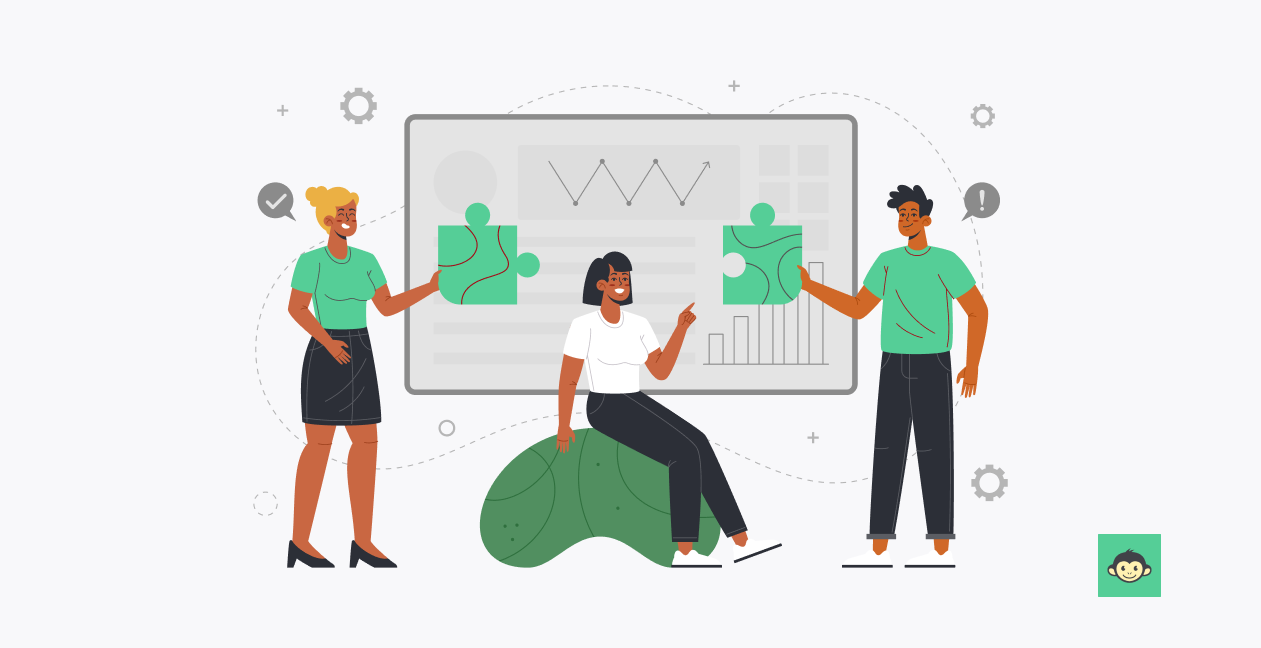75+ DEI tips you should follow at the workplace to improve your belongingness

Remember mix tapes? Hours spent crafting the perfect playlist—some rock, a dash of soul, a guilty-pleasure pop anthem—all carefully chosen to create just the right vibe. You didn’t just throw songs together; you curated them.
That’s how DEI should work in our organizations. It’s not about adding a few different “tracks” and hitting shuffle. It’s about intentionally creating harmony—where every voice, every background, every experience adds depth to the collective sound. As leaders, we’re the ones holding the aux cord.
Are we just replaying the same old favorites? Or are we building something richer, more inclusive, more human? Let’s dig into some DEI tips that go beyond performative playlists—and actually change the tune of your workplace culture.
What is DEI at work?

DEI stands for Diversity, Equity, and Inclusion, and it represents a comprehensive approach aimed at creating a workplace that values and respects individual differences while ensuring equal opportunities for all employees.
Diversity
DEI recognizes and embraces differences and diverse talent, in terms of race, ethnicity, gender, age, sexual orientation, religion, disability, and more. A diverse workforce brings together unique perspectives, experiences, and talents, enriching the organization's creativity and innovation.
Equity
Equity involves leveling the playing field to ensure that all employees have equal access to opportunities, resources, and advancement. It addresses historical disparities and strives to eliminate systemic barriers that might hinder certain groups from thriving.
Inclusion
Inclusion refers to fostering an environment where every employee feels valued, respected, and empowered to contribute their best. Inclusive workplaces encourage open dialogue, collaboration, and a sense of belonging for all employees.
DEI initiatives encompass a range of strategies, such as implementing diverse hiring practices, providing inclusive training, creating affinity groups, promoting leadership development for underrepresented groups, and consistently evaluating and adjusting policies to ensure fairness and inclusivity.
Studies have shown that organizations that prioritize DEI enjoy benefits like enhanced innovation, better decision-making, increased employee engagement, and improved organizational performance.
DEI is not just a concept but a proactive effort to cultivate a workplace that reflects the diversity of society, fosters a culture of fairness, and harnesses the strengths of a varied workforce for collective success.
What is the importance of DEI at work?

The importance of Diversity, Equity, and Inclusion (DEI) in the workplace cannot be overstated. DEI initiatives go beyond being a mere checkbox for organizations; they are integral to creating a thriving, innovative, and harmonious work environment. Here's why DEI is crucial:
- Enhanced innovation: Diverse teams bring together individuals with varied backgrounds, experiences, and perspectives. This diversity sparks creativity and innovative problem-solving, leading to the development of unique solutions and products.
- Better decision-making: Inclusive environments encourage open discussions and the consideration of diverse viewpoints. This leads to well-rounded decisions that take into account various perspectives and potential challenges.
- Increased employee engagement: When employees feel valued, respected, and included, they are more engaged and motivated to contribute their best. An inclusive culture fosters a sense of belonging, leading to higher job satisfaction and reduced turnover.
- Improved organizational performance: DEI contributes to better business outcomes. A study found that companies with diverse leadership are more likely to outperform those with less diversity in terms of profitability.
- Access to a broader talent pool: Embracing a diverse candidate pool of potential employees, allowing organizations to attract top talent from different backgrounds, skills, and experiences.
- Enhanced reputation: Organizations that prioritize DEI establish themselves as socially responsible and forward-thinking. This attracts customers, partners, and investors who value a diverse and inclusive approach.
- Mitigation of bias: DEI initiatives help identify and rectify unconscious biases that might affect hiring, promotions, and decision-making. This promotes fairness and creates equal opportunities for all.
- Stronger employee relationships: An inclusive environment fosters positive relationships among employees, creating a sense of unity and shared purpose.
- Compliance and legal considerations: Many regions have laws and regulations that promote diversity and prohibit discrimination. Implementing DEI measures ensures legal compliance and prevents potential legal issues.
- Global competitiveness: As organizations expand globally, diverse teams understand and cater to the needs of a diverse customer base, improving international competitiveness.
- Enhanced employee well-being: Prioritizing DEI at work significantly improves the overall well-being of employees. When individuals feel accepted and supported for who they are, they experience less stress and anxiety, leading to better mental and emotional health.
- Innovation in problem-solving: Diversity of thought, stemming from a diverse talent pool, brings unique approaches to problem-solving. Different perspectives challenge the status quo and lead to more comprehensive solutions to complex issues.
- Enhanced product development: Inclusive teams are more likely to create products and services that cater to a wider audience. By incorporating diverse perspectives during development, organizations can better meet the evolving demands of a multicultural market, ensuring long-term success and sustainability.
- Higher employee retention: Employees are more likely to stay with an organization that values and promotes diversity and inclusion. DEI initiatives can lead to lower turnover rates and a more stable, experienced workforce.
- Enhanced collaboration and teamwork: DEI initiatives foster an environment where diverse perspectives and approaches are valued. This inclusivity encourages collaboration and teamwork, as employees feel more comfortable sharing their ideas and working together.
Benefits of DEI in the workplace
Implementing DEI isn’t just a trend—it’s a business imperative that drives long-term success, innovation, and employee satisfaction in any DEI workplace.
- Enhanced innovation and creativity: When teams are diverse in background and thought, innovation thrives. One dei tip of the week is to leverage unique perspectives to spark creative solutions. Diversity brings out ideas that homogeneous teams might overlook, making it a powerful inclusion tip.
- Improved employee engagement: Employees who feel seen and heard are more engaged. A DEI tip for today is to create spaces where all voices matter. Engaged DEI employees are more committed and collaborative, positively impacting the overall culture.
- Better decision-making: Diverse teams make better, more balanced decisions. It’s one of those workplace diversity tips that pays off quickly. With varied perspectives, organizations avoid groupthink—an essential diversity tip for fast-growing teams.
- Stronger employer brand: Companies prioritizing diversity equity inclusion attract top talent. Candidates now care deeply about what is DEI program and why DEI is important. It reflects on the values of your business and boosts your public image.
- Increased profitability: Studies show inclusive companies outperform financially. A solid equity tip is to align DEI with business goals. The connection between performance and DEI is clear, reinforcing what does DEI mean in real business terms.
- A more inclusive culture: The ultimate goal of any DEI program is a workplace where everyone feels they belong. What is DEI team doing to reinforce culture? Start with these diversity equity and inclusion tips and good DEI tips for lasting change.
What are the 5 steps of DEI?

DEI isn't just about ticking checkboxes; it's about creating a company culture where everyone can thrive. So, let's dive into the five crucial steps to achieve this.
- Assessment and awareness: Start by taking a long, honest look in the mirror. Assess your current diversity, equity, and inclusion landscape—it’s not just about numbers. Dig into your culture, policies, and practices. This foundational inclusion tip helps identify what’s working and what’s not.
- Setting clear goals: With awareness comes action. Set measurable, specific goals that reflect your values. Whether it's increasing representation or addressing pay equity, this step anchors your DEI tip of the week in purpose.
- Education and training: What is DEI program without education? Ongoing training fosters empathy and cultural competence, which are essential workplace diversity tips for lasting impact.
- Inclusive policies: Review your systems to eliminate bias. Rethink hiring, offer flexibility, and support diverse groups—an essential diversity tip for creating equity.
- Measurement and accountability: Track progress, share results, and adjust as needed. Transparency turns intention into impact—today’s essential DEI tip for today.
What are the 4 pillars of DEI?

Diversity, Equity, and Inclusion (DEI) is like the four legs of a sturdy table. Remove one, and the whole structure becomes shaky. So, let's break down the four essential pillars that support a thriving DEI ecosystem.
1. Diversity:
Diversity is the spice of life, and it's the first pillar of DEI. It's all about recognizing and celebrating differences among individuals, whether those differences are related to race, gender, age, sexual orientation, or any other dimension.
Embracing workplace diversity means not just acknowledging these differences but actively seeking to include and represent them in your organization. It's about inviting a rich tapestry of perspectives to the table, which ultimately fuels innovation and creativity.
2. Equity:
Equity is the second pillar, and it's the bridge that connects workplace diversity to inclusion. It means ensuring that every individual, regardless of their background or identity, has an equal opportunity to succeed.
It's about dismantling barriers and addressing systemic inequalities that might exist in your workplace. Equity is not just about treating everyone the same; it's about recognizing and rectifying historical disadvantages to level the playing field.
3. Inclusion:
Inclusion is the third pillar, and it's where the magic happens. Having a diverse and inclusive workforce is just the beginning; inclusion is about making everyone feel valued and heard. It means creating a workplace culture where every voice matters, where people can bring their authentic selves to work without fear of discrimination.
Inclusive environments foster a sense of belonging, which leads to higher morale, engagement, and productivity.
4. Accountability:
Accountability is the fourth pillar, and it's what keeps the DEI engine running smoothly. It means holding leaders and organizations responsible for their inclusion efforts.
This involves setting clear goals, measuring progress, and taking action when needed. Accountability ensures that DEI isn't just a buzzword but a real commitment to change.
What are DEI objectives?

Diversity, Equity, and Inclusion (DEI) objectives are the compass that guides organizations toward a more equitable and inclusive future. These objectives serve as the roadmap for fostering an environment where every individual can thrive, regardless of their background.
Let's delve into the key DEI objectives that organizations should strive to achieve:
- Representation: A top DEI workplace goal is to ensure diverse voices are present at all levels. This good DEI tip includes promoting diversity into leadership roles. Wondering why DEI is important? Representation drives better ideas and outcomes.
- Eliminating Bias: Bias in hiring and promotion can quietly undermine equity. A practical equity tip is to use fair, structured processes. Removing bias supports diversity, equity, inclusion in real, lasting ways.
- Education and Awareness: Training builds empathy and cultural understanding across teams. Want to know what does DEI mean? It starts with education. One of the good DEI tips is to make learning continuous.
- Employee Engagement: DEI objectives should focus on engaging employees in the DEI journey. This includes creating opportunities for feedback, supporting employee resource groups (ERGs), and encouraging participation in DEI initiatives.
- Community Impact: True DEI work extends beyond office walls. Support local initiatives that align with diversity, equity, inclusion. Ask what is DEI team doing to uplift the broader community?
Why language matters in DEI
The language we use in the workplace directly shapes how people feel, interact, and belong—making inclusive communication essential to any DEI workplace.
- Language shapes perception: The words we use influence how we view others. A DEI tip of the day is to adopt inclusive, respectful language that affirms identity and belonging. This simple shift supports deeper diversity and equity inclusion.
- It reflects your values: Using inclusive language shows what your organization stands for. It’s one of the good DEI tips for signaling psychological safety and empathy—key reasons why DEI is important in internal and external messaging.
- Reduces bias and microaggressions: A powerful equity tip is to avoid phrases that stereotype or exclude. These everyday expressions often go unchecked but can alienate DEI employees and harm team dynamics.
- Strengthens team cohesion: Clear, respectful communication builds trust and collaboration. One DEI tip of the week is to use gender-neutral terms and encourage pronoun sharing in meetings—small actions with big diversity tip impacts.
- Supports inclusive leadership: Inclusive language is part of what is DEI program success. Leaders who model inclusive communication create a ripple effect across teams, showing what does DEI mean in daily practice.
- Builds a culture of awareness: Language can educate and empower. Use it to highlight cultural celebrations and diverse stories. These workplace diversity tips help what is DEI team drive awareness in ways that feel organic and meaningful.
How can you improve DEI at work?

Improving Diversity, Equity, and Inclusion (DEI) at work requires intentional efforts and a holistic approach. Here are a few creative ways to enhance DEI within your organization:
- Unconscious bias training beyond awareness: Expand on traditional unconscious bias training by integrating real-world scenarios and personalized feedback. This encourages participants to reflect on their biases and develop practical strategies for unbiased decision-making.
- Inclusive mentorship and sponsorship programs: Establish mentorship and sponsorship initiatives that connect employees from diverse backgrounds with experienced leaders. This not only provides guidance but also creates pathways for underrepresented individuals to access growth opportunities.
- Diverse interview panels: Form diverse interview panels that reflect the backgrounds of candidates. This approach minimizes bias and ensures fair evaluation during the hiring process, fostering a more inclusive workforce from the start.
- Resource groups for allyship: Create allyship-focused resource groups where employees from different backgrounds collaborate to support one another. These groups promote empathy, educate allies, and create a safe space for discussing DEI matters.
- Community engagement initiatives: Engage with local communities to actively recruit and support underrepresented talent. Collaborative programs, workshops, and partnerships with educational institutions can help bridge gaps and attract diverse candidates.
- Inclusive performance reviews: Revamp performance reviews to include discussions on diversity and inclusion contributions. Recognize employees who actively contribute to fostering an inclusive culture alongside their regular job responsibilities.
- Bias free language and communication: Encourage the use of bias-free language and communication throughout the organization. This means avoiding gendered or culturally insensitive language in job descriptions, company communications, and meetings. Implementing inclusive language guidelines helps create a more welcoming and respectful atmosphere.
- Employee feedback and involvement: Regularly seek feedback from employees regarding their experiences with DEI initiatives. Create channels for open dialogue and suggestions for improvement. Involving employees in the decision-making process empowers them to actively contribute to shaping an inclusive workplace.
- Data-driven decision-making: Utilize data analytics to track progress and identify areas that require improvement. Monitoring key performance indicators related to diversity, equity, and inclusion helps organizations make informed decisions and adjust strategies as needed. Data provides insights into the effectiveness of DEI efforts.
- Cultural competency training: Implement cultural competency training programs to educate employees about different cultural norms, values, and practices. This training fosters mutual respect and understanding, enabling employees to interact more effectively with colleagues from diverse backgrounds.
- Flexible work arrangements: Offer flexible work arrangements to accommodate diverse employee needs, such as remote work options, flexible hours, and compressed workweeks. This approach supports employees with different lifestyles and responsibilities, promoting a more inclusive and supportive work environment.
75+ DEI tips at work you should practice at the workplace

Practicing Diversity, Equity, and Inclusion (DEI) in the workplace is essential for fostering a harmonious and productive environment where all employees feel valued and respected. Here are 75+ practical DEI tips to implement at your workplace:
- Leadership commitment: Ensure top leadership actively supports and promotes DEI initiatives.
- Diverse hiring panels: Form diverse interview panels to minimize bias during recruitment.
- Inclusive job descriptions: Use gender-neutral language in job postings and descriptions.
- Implicit bias training: Offer training to recognize and mitigate unconscious biases.
- Inclusive onboarding: Create inclusive onboarding programs to help new employees feel welcome.
- Mentorship and sponsorship: Implement mentorship and sponsorship programs that include underrepresented groups.
- Diversity in leadership: Strive for diverse representation in leadership roles.
- Employee resource groups: Establish resource groups that support and celebrate diversity.
- Inclusive language: Encourage the use of inclusive language in all communications.
- Regular DEI training: Provide ongoing DEI training for all employees.
- Fair compensation: Ensure pay equity across genders and backgrounds.
- Flexible work arrangements: Offer flexible work arrangements to accommodate diverse needs.
- Accessibility: Make the workplace accessible for employees with disabilities.
- Feedback mechanisms: Create avenues for employees to provide feedback on DEI matters.
- Celebrating cultural holidays: Recognize and celebrate cultural holidays and observances.
- Anti-racism initiatives: Implement anti-racism training and policies.
- Supplier diversity: Partner with diverse suppliers and vendors.
- Inclusive meetings: Ensure inclusivity in meetings and discussions.
- Inclusive benefits: Offer inclusive benefits, such as family support, mental health resources, and gender-neutral restrooms.
- Accessible technology: Use technology that is accessible to all employees.
- Promote allies: Encourage employees to be allies to underrepresented groups.
- Transparency: Communicate progress and results of DEI initiatives transparently.
- Employee resource group leadership: Empower employees from underrepresented groups to take leadership roles in Employee Resource Groups (ERGs).
- Intersectionality awareness: Acknowledge the intersectionality of identities.
- Pronoun inclusivity: Encourage the use of pronouns in email signatures and introductions.
- Cultural competence training: Provide training on cultural competence to ensure employees understand and respect cultural differences.
- Fair recruitment practices: Review and revise recruitment practices to eliminate biases.
- Inclusive leadership development: Create leadership development programs that intentionally include underrepresented groups.
- Intersectional pay equity: Analyze pay equity not only by gender but also by race, ethnicity, and other demographics to address disparities holistically.
- Inclusive remote work: Ensure that remote work policies are inclusive and accommodate the needs of employees with disabilities, caregivers, and those who may prefer remote work for various reasons.
- DEI accountability metrics: Establish clear metrics to measure the success of DEI initiatives.
- Supplier diversity goals: Set goals for supplier diversity, aiming to source from a variety of minority-owned businesses and suppliers representing different communities.
- Inclusive promotion criteria: Develop transparent promotion criteria that consider an employee's contributions to fostering an inclusive workplace, alongside their job performance.
- Mentorship circles: Establish small mentorship groups to provide personalized support and guidance to employees from diverse backgrounds.
- Diversity recruiting events: Host events specifically aimed at recruiting diverse talent, such as job fairs or networking events.
- Language translation services: Provide language translation services or resources for employees whose first language may not be the primary language used at work.
- LGBTQ+ inclusivity training: Offer training sessions focused on LGBTQ+ issues and inclusion in the workplace.
- Neurodiversity awareness: Raise awareness about neurodiversity and create an inclusive environment for neurodivergent employees.
- Cultural competency assessments: Conduct assessments to gauge employees' understanding of cultural competence and provide resources accordingly.
- Generational diversity awareness: Offer training on generational differences in the workplace to promote understanding and collaboration across age groups.
- Diversity in client engagement: Ensure diversity in client-facing roles to better serve a diverse client base.
- Accessible employee events: Plan and organize events that are accessible to employees with disabilities.
- Inclusive performance evaluations: Develop evaluation criteria that recognize contributions to DEI efforts alongside job performance.
- Community partnerships: Establish partnerships with local community organizations to support DEI initiatives and outreach efforts.
- Diversity in design and branding: Ensure diversity and representation in company branding, marketing materials, and product design.
- Cultural competency in customer service: Provide training for customer service teams to effectively communicate and support customers from diverse cultural backgrounds.
- Inclusive career development: Offer career development opportunities that are accessible and equitable for all employees.
- Intersectional mentorship: Pair mentors and mentees based on shared experiences of intersectionality.
- Diverse panel discussions: Host panel discussions featuring diverse perspectives on relevant topics within the industry.
- Inclusive parental leave policies: Implement inclusive parental leave policies that support all types of families.
- Gender-inclusive facilities: Ensure workplace facilities accommodate all gender identities, including gender-neutral bathrooms.
- Accessible learning materials: Provide learning materials and resources in multiple formats to accommodate diverse learning styles and abilities.
- Global DEI considerations: Incorporate global DEI considerations into company policies and practices to support employees across different regions and countries.
- Bias-free performance reviews: Train managers to conduct performance reviews without bias, focusing on objective, measurable outcomes.
- Anonymous employee surveys: Use anonymous surveys to gather honest feedback on DEI progress and workplace inclusion.
- Trauma-informed practices: Integrate trauma-informed approaches in HR and management to support mental well-being.
- Annual DEI audits: Conduct yearly audits to assess DEI efforts, identify gaps, and track improvements.
- Diverse vendor directories: Maintain a directory of certified diverse vendors to simplify inclusive procurement.
- Inclusive training facilitators: Hire diverse trainers and speakers to lead DEI sessions and bring varied perspectives.
- Bias interrupters: Use "bias interrupters" in meetings—structured ways to call out and correct biased behavior in real-time.
- Mental health days: Include dedicated mental health days in your wellness policy to support all employees.
- Inclusive dress code policies: Review dress codes to ensure they are respectful of cultural and religious attire.
- Faith-based accommodations: Provide space and flexibility for employees to observe religious practices.
- Allyship programs: Launch structured allyship programs to train and activate employee allies for marginalized groups.
- Inclusive volunteer opportunities: Organize volunteering programs that support diverse causes and communities.
- Diversity storytelling: Encourage employees to share their personal stories related to identity and inclusion.
- Inclusive signage: Ensure signage (restrooms, entrances, etc.) uses inclusive, accessible language and visuals.
- Returnship programs: Offer return-to-work programs for caregivers, veterans, or others re-entering the workforce.
- Leadership shadowing programs: Allow underrepresented employees to shadow leaders and gain insights into leadership roles.
- Multicultural potlucks/events: Celebrate global cultures through food, art, and traditions in team events.
- Recognition for DEI contributions: Reward and recognize employees who actively contribute to DEI initiatives.
- Gender transition support: Create policies and provide resources for employees undergoing gender transition.
- Immigration support services: Provide legal or logistical support for employees dealing with immigration challenges.
- Language inclusivity guidelines: Create internal communication guidelines that promote gender-neutral and respectful language.
- Accessible career ladders: Map out transparent paths to promotion that accommodate varying backgrounds and experiences.
- Bias-free tech tools: Review AI or hiring tools for embedded biases and ensure they support DEI standards.
- Inclusive wellness programs: Design wellness initiatives that consider physical, mental, and cultural wellness needs.
- Board-level DEI representation: Ensure your board of directors reflects the diversity you aim for in the workplace.
13 DEI training ideas to try in 2025

As Diversity, Equity, and Inclusion (DEI) continue to gain importance in workplaces, innovative training ideas are crucial to fostering a more inclusive culture. Here are 13 DEI training ideas to consider implementing in 2024:
- Storytelling workshops: Encourage employees to share personal experiences related to DEI. Storytelling humanizes diversity, helping others understand different perspectives and challenges.
- Experiential learning: Use interactive simulations or role-playing exercises that simulate bias or discrimination scenarios. This hands-on approach allows participants to experience and address bias directly.
- Inclusive leadership retreats: Host retreats or off-site events for leaders to delve deep into DEI topics. These retreats promote self-awareness, introspection, and collaboration among leadership.
- DEI book clubs: Create DEI-focused book clubs where employees read and discuss books related to diversity, equity, and inclusion. This encourages ongoing learning and dialogue.
- Reverse mentoring programs: Pair senior leaders with junior employees from different backgrounds. This mutual learning experience helps leaders gain insights into the experiences of underrepresented groups.
- DEI gamification: Develop DEI-themed games or quizzes that engage employees while educating them on DEI principles. Gamification makes learning fun and memorable.
- Cross-cultural workshops: Offer workshops that explore different cultures, customs, and traditions. These sessions foster cultural competence and an appreciation for global diversity.
- Inclusive communication workshops: Conduct workshops that focus on improving communication skills in diverse teams. Emphasize active listening, effective feedback, and constructive dialogue to foster open and inclusive conversations.
- Intersectionality training: Offer training sessions that delve into the concept of intersectionality, helping employees understand how various aspects of an individual's identity intersect and impact their experiences. This awareness promotes a more nuanced understanding of diversity.
- Allyship training: Provide training on allyship, teaching employees how to actively support and advocate for underrepresented colleagues. Empowering allies is an integral part of creating an inclusive workplace.
- Inclusive design thinking workshops: Explore design thinking methodologies through the lens of inclusivity. Encourage employees to develop products, services, and solutions that consider the diverse needs and perspectives of all users.
- DEI webinars and podcasts: Extend DEI learning through webinars and podcasts that feature expert speakers and real-world case studies. These digital formats make it easy for employees to access DEI education at their convenience.
- Story circles: Expand on storytelling workshops by creating small group "story circles" where employees can share their experiences and engage in deeper, more intimate discussions. This approach fosters empathy and builds connections among colleagues.
How can organizations promote DEI in remote workplaces?
Promoting DEI in remote work environments requires intention, consistency, and inclusive digital practices that support every employee—no matter where they are.
- Create inclusive virtual meeting norms: Remote meetings should offer equal participation opportunities for everyone. A key dei tip for meetings is to rotate facilitation roles and encourage input from quieter team members. Accessibility features like captions also foster inclusion.
- Ensure equitable access to resources: Equity starts with ensuring all remote employees have access to the same tools and support. One of the most practical DEI tips for work is offering stipends, equipment, or tech assistance to level the playing field.
- Offer remote-specific DEI training: Tailor diversity and inclusion tips to remote contexts. Train managers to recognize digital bias and foster virtual psychological safety. These targeted programs reinforce the goals of what is the DEI program in distributed teams.
- Celebrate global and cultural diversity: Recognize time zones, religious holidays, and regional events. A DEI tip of the day for work is to create shared cultural calendars that make everyone feel represented and respected.
- Encourage informal digital connections: Remote work can feel isolating. Foster inclusion with virtual coffee chats, ERGs, and team storytelling. These spaces humanize coworkers and bring what is DEI mean into everyday interactions.
- Track inclusion across locations: Use surveys and feedback loops to assess inclusion remotely. These insights guide DEI tips for work that actually reflect employee experiences and help adjust strategies as needed.
How DEI is linked to employee retention?

Diversity, Equity, and Inclusion (DEI) initiatives are closely linked to employee retention in several significant ways:
- Inclusive work environment: DEI efforts promote a more inclusive workplace culture where all employees feel valued and respected. When employees feel like they belong, they are more likely to stay with the organization.
- Career development opportunities: DEI initiatives often include mentorship and sponsorship programs that provide underrepresented employees with opportunities for skill development and career advancement. When employees see a path for growth, they are less likely to seek opportunities elsewhere.
- Reduced turnover due to discrimination: Discrimination and bias in the workplace can lead to employee dissatisfaction and turnover. DEI initiatives work to eliminate these issues, reducing turnover stemming from discrimination.
- Enhanced employee engagement: Inclusive workplaces tend to have higher levels of employee engagement. Engaged employees are more committed to their work and less likely to leave.
- Improved leadership representation: DEI initiatives aim to increase diversity in leadership roles. When employees see leaders who look like them or share similar backgrounds, they are likelier to stay and aspire to leadership roles.
- Positive reputation: Organizations known for their commitment to DEI often have a positive reputation. Employees are proud to work for such organizations, which can contribute to higher retention rates.
- Increased collaboration: DEI encourages diverse perspectives and collaboration among employees with different backgrounds. This fosters a sense of teamwork and camaraderie, making employees less likely to leave for a less inclusive environment.
- Global competitiveness: In today's global marketplace, diverse and inclusive teams are better equipped to understand and serve diverse customer bases. This can lead to increased business success, supporting job stability and retention.
- Alignment with employee values: Many employees prioritize working for organizations that align with their values, including DEI values. When an organization demonstrates a commitment to DEI, it resonates with employees who share those values.
- Reduced costs: High turnover is costly in terms of recruitment, onboarding, and training. DEI efforts can reduce these costs by improving retention rates.
Top 7 DEI mistakes to avoid at workplace

Embracing Diversity, Equity, and Inclusion (DEI) in the workplace is a journey that requires careful navigation. While striving for a more inclusive culture, it's essential to steer clear of common pitfalls.
Here are the top 7 DEI mistakes to avoid:
- Tokenism: One of the most significant mistakes is treating DEI efforts as mere window dressing. Tokenism occurs when organizations make superficial gestures to appear inclusive without making substantial changes. Avoid showcasing a single diverse hire as if it's the ultimate achievement.
- Lack of leadership commitment: Without genuine support from leadership, DEI efforts are bound to falter. A lack of commitment from top-level executives sends a message that DEI is not a priority. To avoid this mistake, engage leaders who champion DEI, set an example, and allocate resources for its implementation.
- Ignoring unconscious bias: Ignoring unconscious bias is a significant error in the DEI journey. These biases can affect hiring, promotions, and decision-making processes. To counter this, organizations must implement training programs that raise awareness about unconscious biases and strategies to mitigate them.
- Lack of accountability: Without clear accountability, DEI initiatives can lose momentum. Setting clear goals, tracking progress, and holding individuals and teams responsible for outcomes are essential. A lack of accountability can make DEI efforts seem insincere and ineffective.
- Focusing solely on hiring: Diversity should not be confined to just the hiring process. Neglecting DEI efforts beyond recruitment is a common mistake. To foster an inclusive culture, ensure that diversity and equity are embedded in all aspects of the workplace, from policies and practices to everyday interactions.
- Failure to listen to employee voices: Employees' voices are a valuable resource in your DEI journey. Failing to actively listen to their experiences, concerns, and suggestions is a mistake. Create channels for feedback and engage with employees through surveys, focus groups, or open forums to understand their perspectives.
- Neglecting ongoing education: DEI is not a one-time fix but an ongoing process. Neglecting continuous education and awareness programs is a mistake. Regular training and education initiatives help keep DEI at the forefront of employees' minds and reinforce a culture of inclusion.
What is an effective DEI strategy?

DEI is a journey towards fostering a workplace where every individual feels valued and empowered. Here are nine strategies to help you build an impactful DEI strategy that goes beyond rhetoric and drives real change.
- Leadership commitment: Start at the top. Your DEI strategy needs unwavering support from your leadership team. Encourage them to not only endorse DEI but also actively engage in it. When leaders walk the talk, it sends a powerful message throughout the organization.
- Clear goals and objectives: Set specific, measurable, and time-bound goals for your DEI efforts. Whether it's increasing the representation of underrepresented groups in leadership roles or reducing unconscious biases in hiring, having clear objectives helps focus your strategy.
- Inclusive hiring and promotion: Review your hiring and promotion processes. Implement strategies that reduce bias and promote fairness. This could include blind recruitment, diverse interview panels, or mentorship programs to nurture talent from underrepresented groups.
- Training and education: Invest in DEI training for your workforce. These programs can help employees recognize and address biases, foster empathy, and build cultural competence. Education empowers individuals to be part of the solution.
- Inclusive policies and practices: Audit your existing policies and practices to identify any systemic biases. Make necessary changes to create a more inclusive environment. This could involve offering flexible work arrangements, parental leave policies, or accommodations for individuals with disabilities.
- Employee Resource Groups (ERGs): Encourage the formation of Employee Resource Groups that provide safe spaces for employees to connect and share experiences. These groups can be invaluable in shaping your DEI initiatives and fostering a sense of belonging.
- Diverse leadership: Ensure that your leadership team reflects the diversity you aim to achieve throughout the organization. Diverse perspectives at the top can lead to more inclusive decision-making and a stronger commitment to DEI.
- Regular measurement and reporting: Track your progress diligently. Regularly assess whether you're meeting your DEI goals and share this data transparently with your employees and stakeholders. Measurement keeps you accountable and demonstrates your commitment to transparency.
- Community engagement: Engage with your local community and industry peers to share best practices and learn from others. Participate in DEI-related events, sponsor initiatives, and collaborate to drive broader societal change.
What are DEI action steps?

Diversity, Equity, and Inclusion (DEI) are not just buzzwords; they require concrete action steps to create meaningful change within organizations. Let's dive into some essential DEI action steps to turn intentions into results:
- Conduct a DEI Assessment: Start by understanding your organization's current DEI landscape. This assessment should encompass demographic data, employee surveys, and a thorough examination of policies and practices. It's like knowing where you are on a map before planning your journey.
- Develop DEI strategies: Once you have your goals, craft actionable strategies to achieve them. This might involve changes in recruitment practices, training programs, or revising policies to eliminate biases.
- Implement training and education: Provide DEI training and education for employees. These programs should raise awareness about biases, promote cultural competence, and encourage open dialogue about DEI issues.
- Review and adjust policies: Regularly review and adjust policies and practices to eliminate bias and promote equity and inclusion. This includes examining hiring, promotion, and compensation policies to ensure fairness.
- Create inclusive workspaces: Foster an inclusive workplace culture where all employees feel valued and heard. Encourage diverse perspectives, and provide opportunities for employees to share their experiences and insights.
- Measure progress: Regularly measure and report on your progress toward DEI goals. This data-driven approach holds your organization accountable and helps identify areas that need improvement.
- Engage with the community: Extend your DEI efforts beyond your organization. Engage with your local community and industry peers to share best practices and support broader DEI initiatives.
Significance of DEI software to improve inclusivity at the workplace

Diversity, Equity, and Inclusion (DEI) software can be a powerful tool for organizations looking to measure and improve inclusivity in the workplace. Here are several significant reasons why such software is crucial:
- Data-driven insights: DEI software provides data and analytics that offer insights into the current state of diversity and inclusion within the organization. It helps identify areas that need improvement and allows for informed decision-making.
- Continuous monitoring: DEI software enables continuous monitoring of DEI metrics. It's not a one-time assessment but an ongoing process, ensuring that progress is tracked and interventions are timely.
- Objective assessment: Software tools provide an objective assessment of DEI, minimizing biases that might occur in manual evaluations. This ensures fairness and accuracy in assessing inclusivity.
- Employee feedback: Many DEI software solutions incorporate features for gathering employee feedback on DEI-related issues anonymously. This gives employees a safe platform to voice their concerns and suggestions.
- Benchmarking: DEI software often allows organizations to benchmark their DEI performance against industry standards and competitors. This benchmarking helps set realistic goals and targets.
- Customization: Organizations can tailor DEI software to their specific needs and goals. This flexibility ensures that the software aligns with the organization's unique DEI strategy.
- Training and education: Some DEI software includes training modules to educate employees on diversity and inclusion topics. This promotes awareness and helps in behavior change.
- Accessibility: DEI software often comes with accessibility features, ensuring that all employees, including those with disabilities, can actively engage with the platform.
- Efficiency: DEI software streamlines data collection and reporting processes. This saves time and resources compared to manual data gathering and analysis.
- Accountability: Having a dedicated DEI software signals a commitment to diversity and inclusion. It holds the organization accountable for progress and sends a clear message to employees and stakeholders.
- Legal compliance: DEI software helps organizations stay compliant with legal requirements related to diversity and inclusion reporting.
- Global reach: For multinational organizations, DEI software can be adapted to accommodate different cultural contexts and languages, making it a valuable tool in global DEI efforts.
- Transparency: Using DEI software fosters transparency in DEI initiatives, enhancing trust among employees and stakeholders.
- Competitive advantage: Organizations that excel in DEI often have a competitive advantage in attracting top talent and appealing to a diverse customer base.
- Measurable results: Ultimately, DEI software helps organizations measure the impact of their DEI efforts, ensuring that inclusivity becomes a quantifiable and achievable goal.
Conclusion
Fostering diversity, equity, and inclusion in the workplace isn’t a one-time initiative—it’s an ongoing, transformative process. Throughout this blog, we’ve explored practical DEI tips, common pitfalls, and strategies to build a more inclusive environment.
By actively embedding DEI principles into everyday practices, organizations set the foundation for long-term growth, innovation, and employee well-being. One way to start this journey is by leveraging tools like a DEI survey.
These surveys provide meaningful insights into employee experiences, helping you uncover gaps, measure sentiment, and track the progress of your DEI initiatives. When done right, a DEI survey becomes more than a feedback tool—it becomes a mirror, reflecting where you stand and what needs to evolve.
We believe that building inclusive cultures starts with listening. Our platform equips organizations with the tools to gather, analyze, and act on employee feedback—especially around DEI. By combining actionable insights with employee-centric engagement strategies, CultureMonkey empowers leaders to create workplaces where every voice is heard and valued
FAQs
1. Why is DEI important in the workplace?
DEI is important in the workplace because it fosters fairness, equity, and inclusivity, creating an environment where all employees feel valued and can contribute their best. Diverse and inclusive workplaces enhance creativity, innovation, and decision-making, leading to better business outcomes. Prioritizing DEI helps attract and retain top talent and improves employee engagement.
2. How can I incorporate DEI tips into my daily work routine?
Start by adopting inclusive language, actively listening to colleagues from diverse backgrounds, and seeking opportunities to learn about different cultures and perspectives. Participate in diversity training, join employee resource groups, and advocate for inclusive policies and practices. Encourage open dialogue, support diverse initiatives, and mentor colleagues from underrepresented groups.
3. What role do leaders play in promoting DEI?
Leaders should champion DEI initiatives, set an example by embracing diversity, and create an inclusive environment. They can also support DEI training and mentorship programs to empower employees and foster a culture of belonging. By advocating for equitable policies and promoting diverse representation in leadership roles, leaders cultivate a workplace where every voice is heard and valued.
4. How do I address bias and discrimination in the workplace?
Address bias by promoting awareness through training, reporting incidents of discrimination, and actively supporting colleagues who face bias. Encourage open dialogue about these issues to create a culture of accountability and understanding. Implement policies that prioritize fairness and inclusivity, and regularly assess progress toward a bias-free workplace. Together, these efforts foster an environment where diversity thrives.
5. Are there any statistics that highlight the benefits of DEI in the workplace?
Yes, studies have shown that diverse and inclusive organizations tend to have higher profitability, employee engagement, and innovation. For example, McKinsey & Company's research has highlighted the positive correlation between gender and ethnic diversity and business performance. Embracing diversity not only enhances creativity and decision-making but also attracts a broader customer base and strengthens the organization's reputation.
6. How can companies address unconscious bias?
To reduce unconscious bias, organizations should implement regular training and review internal systems for hidden disparities. A solid equity tip is to audit hiring and promotion data. This DEI tip for today reminds us why DEI is important for fairness. Embedding these diversity equity and inclusion tips into everyday routines builds a more equitable DEI workplace.
7. How can employee resource groups (ERGs) support DEI?
ERGs give DEI employees a platform to share, connect, and lead initiatives. These groups are a DEI tip of the week for amplifying underrepresented voices. Wondering what is DEI team impact? Start here. ERGs also reinforce what is the DEI program through grassroots engagement and support, offering one of the most practical DEI tips for work.
8. How can organizations celebrate diversity effectively?
Celebrating diversity means honoring cultures, identities, and perspectives year-round. Incorporate holidays, heritage months, and storytelling events into the calendar. A dei tip of the day for work is to make these efforts inclusive of all voices. This inclusion tip is essential for living the true DEI meaning and embracing diversity equity inclusion in your DEI workplace.



